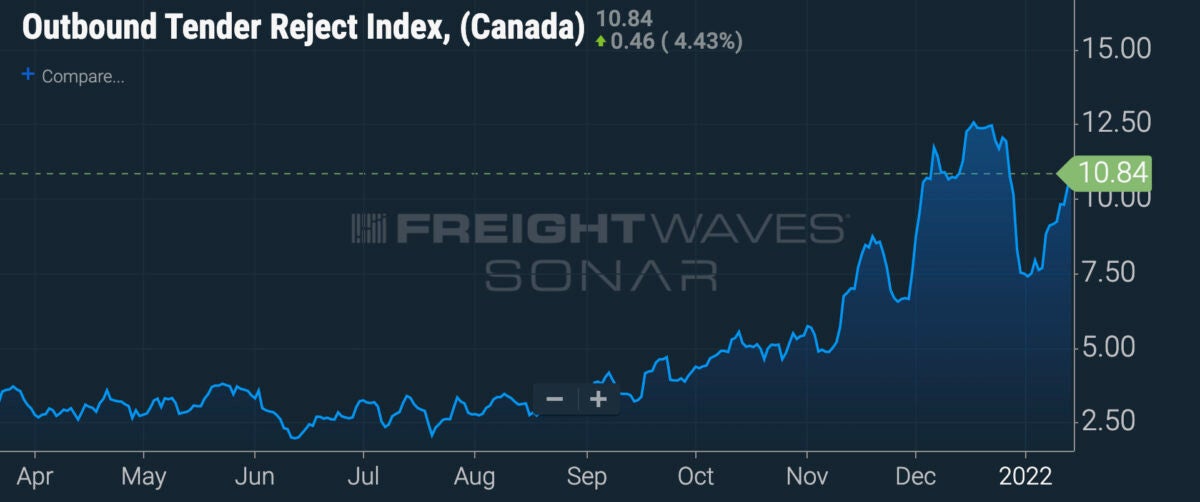Starting on Saturday, the cross-border trucking community faces the first stage of vaccine mandates. The Canadian government is implementing its restrictions first. U.S. truckers will only be able to cross the border if they can show proof that they have been fully vaccinated against COVID-19. Meanwhile, unvaccinated or partially vaccinated Canadian truckers face testing and quarantines. A week later, on Jan. 22, the U.S. is expected to implement a similar policy on its borders with Canada and Mexico.
The vaccine mandates, first announced in October, mark an end of an era of sorts for cross-border truckers during the pandemic. Since March 2020, truckers along with other essential workers, have been exempt from the various restrictions imposed on regular travelers. Despite pushback from industry groups, including the Canadian Trucking Alliance, American Trucking Associations and the Owner-Operator Independent Drivers Association, the mandates appear to be going forward as planned.
1. What will truckers need to cross the Canadian border?
U.S. drivers won’t be allowed to cross the border unless they can show that they have been fully vaccinated against COVID-19 with shots that are accepted in Canada. Acceptable vaccines include two shots of Pfizer-BioNTech, Moderna, AstraZeneca, a single dose of Johnson & Johnson. Drivers are being told to submit their proof of vaccination in advance through a government app called ArriveCan, but also to have a paper copy too available to show Canada Border Services Agency officers.
The situation is a bit different for Canadian drivers since citizens and permanent residents can’t be barred from entering the country. Instead, unvaccinated and partially vaccinated drivers face mandatory quarantines and testing after arrival.
2. How many drivers are expected to drop out of U.S.-Canada cross-border trucking?
The Canadian Trucking Alliance and American Trucking Associations have projected that 26,000 of 160,000, or a little over 16%, drivers will no longer cross the border because of the mandates. Around 75% of the freight hauled between the countries is handled by Canadian drivers. Meanwhile, about 88% of Canadians over 12 are fully vaccinated. As CTA President Steve Laskowski pointed out, “We have a high vaccination rate. But even at 10% to 15%, that’s a lot of trucks.”
Craig Germain, chief operating officer of Toronto-area-based XTL Transport, said only a handful of its drivers have opted to stay unvaccinated. As a result, it won’t be a serious issue.
“There’s probably going to be enough domestic freight. They’ll have a job. The question will be, will they want to go back and do cross-border,” Germain said.
Despite XTL’s high vaccination rate, Germain said the larger industry will likely see a significant loss of cross-border drivers, especially at smaller carriers based outside of larger urban areas.
“You’ll see a culmination,” he said. “If someone’s got a busy enough domestic operation, they’ll slide the capacity over there. But it doesn’t replace those trucks across the board.”
3. But will that many drivers actually leave?
Not everyone thinks there will be a mass exodus of truckers.
Matt Silver, founder and CEO of Chicago-based cross-border logistics firm Forager, said economics will prevail over the desire to remain unvaccinated.
“They have to make a choice: Do they want to keep earning money or do they want to be stubborn?” Silver said. “I think it will have a small effect.”
Watch now: Should drivers get vaccinated?
However, the calculus is going to be different for U.S. versus Canadian drivers. The domestic U.S. freight market is largely more lucrative than the Canadian one. In short, Canadian drivers take a bigger hit by dropping out of cross-border work. There’s also more competition for domestic Canadian trucking jobs.
Peter Stefanovich, president of Toronto-based transportation M&A advisory firm Left Lane Associates, thinks any driver exodus will be temporary.
“The vaccine mandate today is no different than what happened in 2018 with the ELD mandate in the U.S.,” he said. “It caused a lot of headaches in the short to mid-term. Drivers left but eventually made their way back.”
4. What are the markets telling us?

Capacity in Canada tightened significantly in December, and that trend has continued into January, according to data from FreightWaves’ SONAR platform and conversations with brokers. There are many factors at play. Volumes have been strong. Catastrophic weather hit British Columbia — and key rail lines. Many fleets haven’t been at full capacity with vacations and people getting sick from the Omicron variant. As a result, even a small reduction in cross-border trucking capacity could have a big impact.
Rob Piccioni, CEO of Montreal-based Fuel Transport, said his firm’s freight brokerage isn’t seeing any significant loss of capacity from its partner carriers.
“It hasn’t been like, ‘Hey, we’ve lost a bunch of drivers,’” Piccioni said.
Piccioni said he doesn’t expect an immediate, catastrophic shock to the supply chain. But rather a slow burn that will get worse in the spring as volumes go up.
“We’ll see the impact in February and March,” he said. “Right now, it’s too early to tell.”
5. What happens next?
The U.S. government moved first in announcing a vaccine mandate for foreign essential workers crossing its borders, including truckers. It hasn’t come out publicly with a precise start date, but multiple reports, citing anonymous senior officials, have said it will happen on Jan. 22.
But the lack of an official date and unclear directives about how this will work for Canadian drivers entering the U.S. has raised eyebrows.
The CTA’s Laskowski said he is concerned the industry doesn’t have a clear directive about how drivers will be complying with proof of vaccination requirements on the U.S. side.
“We have concerns about showing compliance because we turn the page towards ensuring that vaccinated drivers get across the border and with the loads they’re carrying, we need a system of compliance. That is very reasonable for the trucking industry,” Laskowski said.







